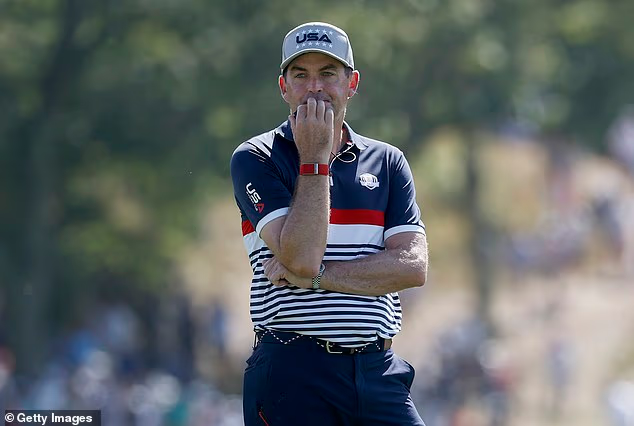High Tensions and Heated Exchanges: A Look at the Ryder Cup’s Fiery Second Day
The Ryder Cup, a hallmark event in professional golf, witnessed an electrifying and contentious second day that polarized players and fans alike. Keegan Bradley, one of the American players, found himself amidst a whirlwind of emotions as the New York crowd’s passionate support transformed into a volatile atmosphere. This level of intensity, while exhilarating for some, was marked by hostility that raised eyebrows and prompted serious discussions about crowd behavior in sports.
The Setting: A Historical Venue
Taking place at the renowned Bethpage Black, a course synonymous with challenging play and intense competition, the event wasn’t just another golf match. It was a battleground where national pride and player rivalries fueled an already electrifying atmosphere. However, the tournament took a significant downturn as disrespectful chants and jeers flooded the air, making it exceedingly difficult for players to focus on their game.
A Historic Lead for Europe
Despite the chaos unfolding off the greens, Europe seized the day, establishing a remarkable seven-point lead going into the final showdown. This commanding position for the European team showcased their resilience and skill, as they expertly navigated both the course and the increasingly hostile crowd. Nevertheless, the fanatical support of the home crowd had negative repercussions, as taunting and heckling escalated to levels that were considered unacceptable in professional sports.
The Unleashing of Hostility
As the match progressed, the notorious New York fans showed their true colors, a blend of passionate support and aggressive provocations aimed particularly at players like Rory McIlroy. Some fans crossed the line with vulgar insults, not just directed at the athletes but also involving their families, further intensifying the hostile environment. The scenes at Bethpage Black evoked memories of previous Ryder Cups where tensions ran high, but this year seemed to take a particularly ugly turn.
Keegan Bradley’s Controversial Comments
In the midst of this, Keegan Bradley took the podium for his post-round press conference, where he characterized the tumultuous crowd behavior as an expression of passionate support from the fans—a stance that was met with mixed reactions. He elaborated that while some fans crossed the line, the overwhelming energy from the crowd was part of what made the Ryder Cup special. This perspective, however, did little to quell criticism and raised questions about the responsibility of players in addressing fan behavior.
Defense or Deflection? The Blame Game
While Bradley attempted to defend the New York crowd’s fervor, he also hinted that the American team’s lack of performance may have fueled the animosity from fans. Amidst this assertion, he quickly backtracked when pressed by reporters, clarifying he did not blame his teammates for the crowd’s unruly behavior. This moment of uncertainty highlighted the complexities of athlete-fan relationships, particularly in high-stakes competitive settings like the Ryder Cup, where performance and perceptions can rapidly shift.
The Player-Fan Dynamic
Tensions escalated as the atmosphere spiraled further out of control, leading to multiple ejections and heightened security measures. Rory McIlroy found himself in the eye of the storm as he publicly expressed his frustrations about the jeering crowd, requesting silence so that he could focus on his game. This moment not only showcased the pressures golfers face but also raised essential questions about the role of sportsmanship among spectators.
Responses from European Captains and Players
Luke Donald, the European captain, took a different approach by framing the loud atmosphere as a motivating factor for his players. He stated that the situation only fueled their competitive drive, allowing them to rise above the taunts. Donald’s comments served to reinforce a positive narrative amid chaos, highlighting the team’s ability to adapt even when faced with adversity—an invaluable trait in competitive sports.
The Role of Law Enforcement
As tensions boiled over, law enforcement became a key player on the sidelines, ensuring that the situation didn’t escalate further. Reports indicated an increased police presence, especially around contentious moments, in an effort to maintain order. The decision to enhance security signifies a growing recognition of the need to protect players and promote respectful fan behavior within the realm of sports.
Lessons Learned: Moving Forward
As the dust settles from this polarizing day at the Ryder Cup, the focus now shifts to the lessons learned. In an age when sports are impacted by social media and public scrutiny, the responsibility of both players and fans is under a microscope. The Ryder Cup serves as a reminder that while passion is essential to the game, it must be tempered with respect for the competitors and their families. Moving forward, the goal should be to foster a sporting environment that celebrates enthusiasm while maintaining the integrity of the game.
In conclusion, the second day of the Ryder Cup at Bethpage Black will likely be remembered for its fiery exchanges and the emotional rollercoaster experienced by players and fans alike. As discussions about sportsmanship and crowd behavior continue, the takeaway remains clear: passion for sport should uplift the game, not degrade it. The essence of sports lies in its ability to unite and inspire—something worth striving for as we reflect on the unforgettable moments from this year’s contentious tournament.


